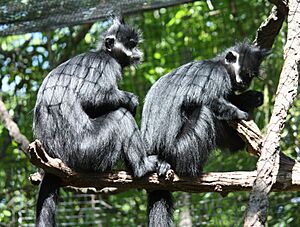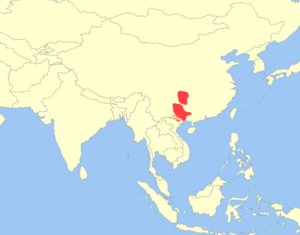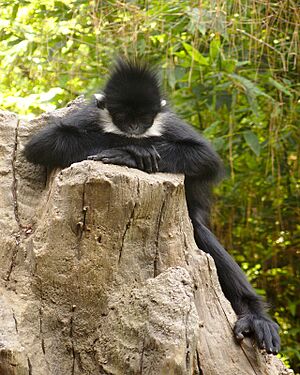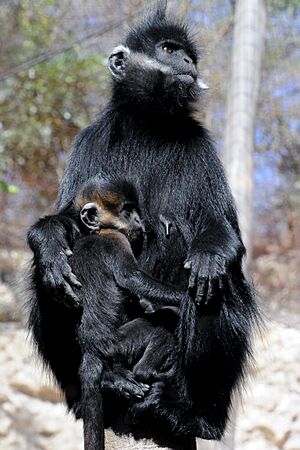François' langur facts for kids
Quick facts for kids François' langur |
|
|---|---|
 |
|
| François' langurs at the Cincinnati Zoo | |
| Conservation status | |
| Scientific classification | |
| Genus: |
Trachypithecus
|
| Species: |
francoisi
|
 |
|
| Geographic range | |
The François' langur (Trachypithecus francoisi) is a type of Old World monkey. It's also called the Francois' leaf monkey or Tonkin leaf monkey. These monkeys are part of a group called Colobinae, and not much is known about them.
You can find François' langurs in Southwestern China and northeastern Vietnam. Sadly, there aren't many left in the wild. Experts think fewer than 500 live in Vietnam and about 1,400 to 1,650 in China. Around 60 langurs live in zoos in North America. This monkey is named after Auguste François, a French consul who worked in southern China.
Contents
What Does a François' Langur Look Like?
François' langurs are medium-sized monkeys. They have black, shiny fur. A cool feature is their distinct white sideburns. These grow from their ears down to their cheeks.
Their stomachs are special, with four parts. This helps them digest their diet of leaves. It's a key way they get nutrients from tough plant material.
Size Differences Between Males and Females
Male and female langurs are different sizes. This is called sexual dimorphism. Males are usually bigger than females.
A male's body can be from 55 to 64 centimeters (21.7 to 25.2 inches) long. Females are a bit smaller, from 47 to 59 centimeters (18.5 to 23.2 inches). Males also have longer tails, about 82 to 96 centimeters (32.3 to 37.8 inches). Female tails are 74 to 89 centimeters (29.1 to 35.0 inches).
Males weigh more too, around 6.5 to 7.2 kilograms (14.3 to 15.9 pounds). Females weigh 5.5 to 5.9 kilograms (12.1 to 13.0 pounds). Baby langurs are tiny at birth, weighing about 0.45 to 0.50 kilograms (15.9 to 17.6 ounces).
Bright Orange Babies
Baby François' langurs are born with bright orange fur. This color slowly changes to black over several months. Scientists aren't sure why their fur is so bright.
One idea is that the bright color helps adults notice them. This might encourage other langurs to protect and care for the babies.
How Their Stomachs Work
François' langurs have large salivary glands. These glands start to break down tough leaf fibers. They also have a unique stomach with two main chambers.
In the first chamber, helpful bacteria continue breaking down the fibers. This part of the stomach has a normal pH level. This creates good conditions for the bacteria to grow. The second chamber is like other mammals' stomachs. It has acids that finish digesting the food.
How Do François' Langurs Behave?

François' langurs are diurnal, meaning they are active during the day. They spend most of their time resting and looking for food. One study found they spend about 35% of their day resting. They spend about 31% of their day foraging for food.
Other activities include traveling, huddling, playing, and grooming. These activities can change with the seasons. For example, they travel more in winter. They huddle more in spring to stay warm.
Social Life and Family
François' langurs live in groups. These groups can have 4 to 27 langurs, but usually around 12. They live in a matriarchal society. This means the females lead the group.
Females in the group share parenting duties. They help each other raise the young. Young males leave the group before they become adults. Baby langurs drink milk for up to two years. After they stop drinking milk, they become like any other member of the group.
What Do They Eat?
More than half of a François' langur's diet is made of leaves. They also eat fruits, seeds, flowers, stems, roots, and bark. Sometimes, they eat minerals and insects from rocks.
They eat young leaves most often during the dry season. When young leaves are harder to find, they eat more seeds and stems. They are picky eaters. In one area, they mostly eat young leaves from just 10 different plant types.
Where Do François' Langurs Live?
François' langurs prefer to live in karst topography. This means areas with limestone cliffs and caves. These are found in tropical and subtropical regions. Living on cliffs helps them find safe places to sleep. They often sleep on ledges or inside caves.
They also find sleeping spots in evergreen forests. These spots are usually above 60 degrees Fahrenheit (15.5 degrees Celsius). Living in these high, rocky places helps them avoid predators. They are very careful when entering caves to sleep. They also make loud calls to mark their territory.
Finding Food and Shelter
Langurs choose sleeping sites close to where they can find food. This saves energy and reduces travel time. The best sleeping spots are not right in the middle of food areas. But they are close enough to make foraging easy.
They often use the same travel routes. They also return to the same sleeping sites for several nights. This helps them avoid predators. François' langurs usually have 6 to 10 regular sleeping sites. They use different ones throughout the year as food and water change.
Their Home Range
François' langurs live in specific areas. They are mostly found in Southwest China and northern Vietnam. Many studies happen in nature reserves in China.
Their home range is about 19 hectares (47 acres). They travel about 341 to 577 meters (1,119 to 1,893 feet) each day. Because their diet of leaves isn't very rich in nutrients, they don't travel far. The largest group ever reported had 500 to 600 langurs. However, the average group size is 4 to 27.
Sadly, in one reserve, the langur population dropped by 73% in five years. Now, they are found in only 14 places across 10 different counties.
Why Are François' Langurs Endangered?

The number of François' langurs has been going down for 30 years. Hunting is one of the biggest threats. Some local people believe the langurs have medicinal value. They hunt them to make wine from their bones. They think this wine can cure tiredness and pain.
In one Chinese province, the population has dropped by 90% since the 1980s. In 1983, there were an estimated 4,000 to 5,000 langurs. But in the 1970s and 1980s, over 1,400 to 1,500 langurs were killed.
Habitat Loss and Predators
Another big threat is the destruction of their habitat. Farmers sometimes light fires on lower slopes to clear land. Limestone, where langurs live, is easily damaged by fire. This destroys their homes and causes food shortages.
Their main predators are animals on the ground and in the air. The clouded leopard can be a predator, but there aren't many of them. Birds like the crested serpent eagle and the mountain hawk-eagle are a bigger danger. They especially hunt young langurs.
Protecting the Langurs
Despite their numbers dropping, efforts to protect them have been slow. There are fewer than 2,500 langurs left. A plan to protect the forests and ban hunting was made in 1996. But it has not been fully put into action.
To save the langurs, hunting must stop. Their habitats also need protection. In 2003, a government agency agreed to increase law enforcement. This helps protect them from hunters. Also, a bank is helping local people build biogas facilities. This reduces the need to cut wood for fuel, which might lower the number of fires. There is also a project to protect the nature reserves where langurs live.


